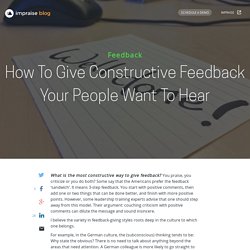

Are You Making These Feedback Mistakes? When it comes to giving someone at work feedback do you tend to step up or step away?

Friend or Foe: How to Give—and Take—Good Feedback. In school, I never cared much about my exam results, other than the overall score penned in red in the upper right corner of my exam sheet.

When the teacher returned the exam papers to the class, I remember sitting at my desk with a beating heart, turning over the paper to see my grade. I was either disappointed or delighted. Then I systematically stuffed the paper into the depths of my backpack, deciding I would never look at it again. My relationship with feedback was avoidant and my formal education never forced me to face my weaknesses. I thought that feedback in the form of exam results existed so that I would feel bad about myself, and my lack of skill and knowledge. Because my relationship with feedback was stained with judgement and guilt, I was completely incapable of looking over the teacher’s corrections.
Fast-forward to the beginning of my working career. Are You Sugarcoating Your Feedback Without Realizing It? Executive Summary Previous research into feedback inflation — when managers are too “nice” to employees while giving negative feedback — has centered on the idea that managers deliberately sugarcoat tough messages for fear of retaliation, or to protect their employees from feeling bad about themselves.

But the authors’ research shows that many managers deliver inflated feedback unintentionally, and in fact think they’ve been much more clear than is the case. Simple prompts can help managers be more accurate, and help them gauge whether their employees have understood the problem. Managers tend to inflate the feedback they give to their direct reports, particularly when giving bad news. And by presenting subpar performance more positively than they should, managers make it impossible for employees to learn, damaging their careers and, often, the company. Avoid The Seagull Effect: The 30/60/90 Framework For Feedback. Has this scenario ever happened to you?

You’ve spent weeks working on a big project. It’s almost near completion and frankly, you’re quite proud of it. You did a ton of research and you fussed over every detail to make sure it’s perfect. Your big presentation is just a few days away and you’re putting on the final touches. But then—suddenly—out of the corner of your eye a little red bell lights up in your peripheral vision indicating a new notification. “Yeahhh I just really think the entire direction of this is a bit off track and I’d consider scrapping it and instead heading in X direction.”
Agh! Beware: The Seagull Effect In this scenario, Neil was demonstrating the fine art of ‘seagulling.’ And like a seagull, once he had his tasty morsel in mouth, he flapped away to squawk at someone else’s beach encampment, not to be heard from again for weeks. Boost Your Team Productivity with Meaningful Work Feedback. Yet another mid-year performance review is approaching.

Employees are running around, discussing top behavior and planning strategies and secretly fearing what they’re going to hear about themselves from their superiors. The frenzy is in the air; the horror is in the hearts. Receiving feedback in the workplace can be a terror-inducing event for many. So how did we end up with work feedback being a horrifying act for the majority of workers out there? As humans, we cannot help but be vulnerable about the evaluation of our efforts. Trustworthiness.
Consulting. How to give constructive feedback your people want to hear. What is the most constructive way to give feedback?

You praise, you criticize or you do both? Some say that the Americans prefer the feedback ‘sandwich’. It means 3-step feedback. You start with positive comments, then add one or two things that can be done better, and finish with more positive points. However, some leadership training experts advise that one should step away from this model. How to build a company where the best ideas win [ TED Talk : Ray Dalio ] The Dot Collector feedback tool to rate employees. When you are the first person to arrive in a meeting room, do you think of it as being empty or full?

If you were raised in the West, a meeting room is made for people to meet. Therefore, if there are no people in that room, then of course it must be empty. As philosopher Henk Oosterling remarks, in the West, “a room is empty until someone enters.” However, in the East, space is understood a bit differently. In Japan, spaces have meanings prior to any activity that happens within them. Instead of framing space as a relationship between objects and walls, the Japanese concept of space is about the relationships among people. Japanese ideas of space Western designers and architects have long found the Japanese concept of space fascinating, but there’s also a lot the rest of us can learn about different cultures and how they approach space as both a concept and a practice.
The Japanese build spaces as extensions of culture and values, rather than as places where culture happens. Coaching Relationship. Improvisational Theatre. Critical Thinking.